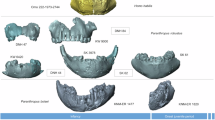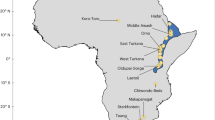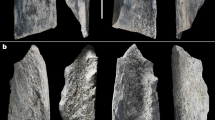Abstract
WOLPOFF1 has recently argued that the cranial capacity of the type specimen of Homo habilis2 from Olduvai Gorge, Tanzania (Olduvai hominid 7), is not sufficiently different from those of South African Australopithecus africanus to warrant placement in a separate species. He arrives at this conclusion by pooling the sets of observations from Olduvai and South Africa, calculating the mean and standard deviation of this “sample”, and showing that the sample coefficient of variation is not unduly high. He also shows that Olduvai hominid 7 falls only 2.03 standard deviations from the sample mean.
This is a preview of subscription content, access via your institution
Access options
Subscribe to this journal
Receive 51 print issues and online access
$199.00 per year
only $3.90 per issue
Buy this article
- Purchase on SpringerLink
- Instant access to full article PDF
Prices may be subject to local taxes which are calculated during checkout
Similar content being viewed by others
References
Wolpoff, M. H., Nature, 223, 182 (1969).
Leakey, L. S. B., Tobias, P. V., and Napier, J. R., Nature, 202, 7 (1964).
Day, M. H., Guide to Fossil Man (Cassell, 1965).
Pilbeam, D. R., and Simons, E. L., Amer. Sci., 53, 237 (1965).
Simpson, G. G., Roe, A., and Lewontin, R. C., Quantitative Zoology (Harcourt, Brace, 1960).
Ashton, E. H., and Spence, T. F., Proc. Zool. Soc. Lond., 130, 169 (1958).
Tobias, P. V., Olduvai Gorge, 2 (Cambridge University Press, 1967).
Author information
Authors and Affiliations
Rights and permissions
About this article
Cite this article
PILBEAM, D. Early Hominidae and Cranial Capacity. Nature 224, 386 (1969). https://doi.org/10.1038/224386a0
Received:
Issue date:
DOI: https://doi.org/10.1038/224386a0
This article is cited by
-
Taxonomy and Cranial Capacity of Olduvai Hominid 7 (continued)
Nature (1970)
-
New Endocranial Values for the Australopithecines
Nature (1970)



